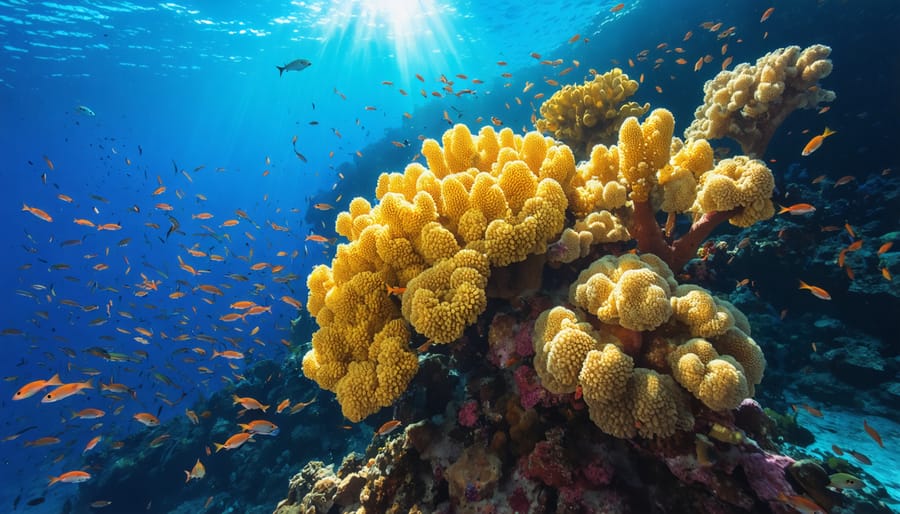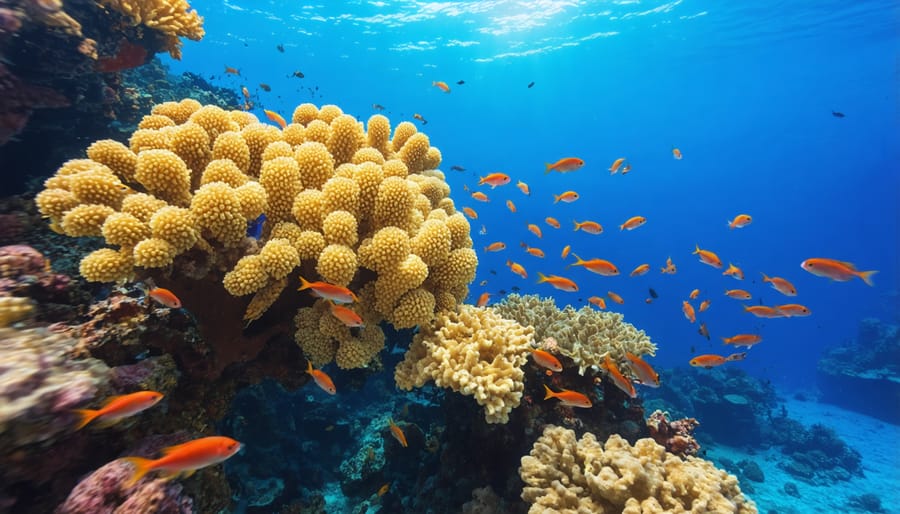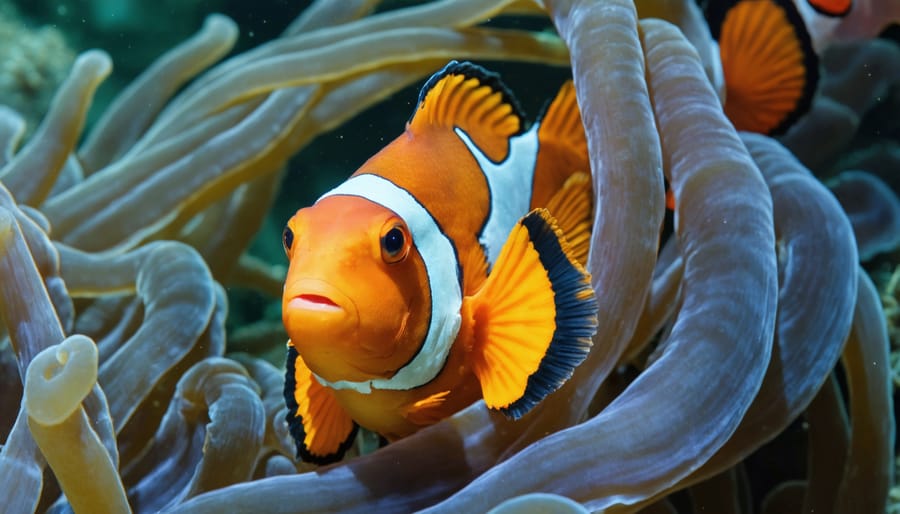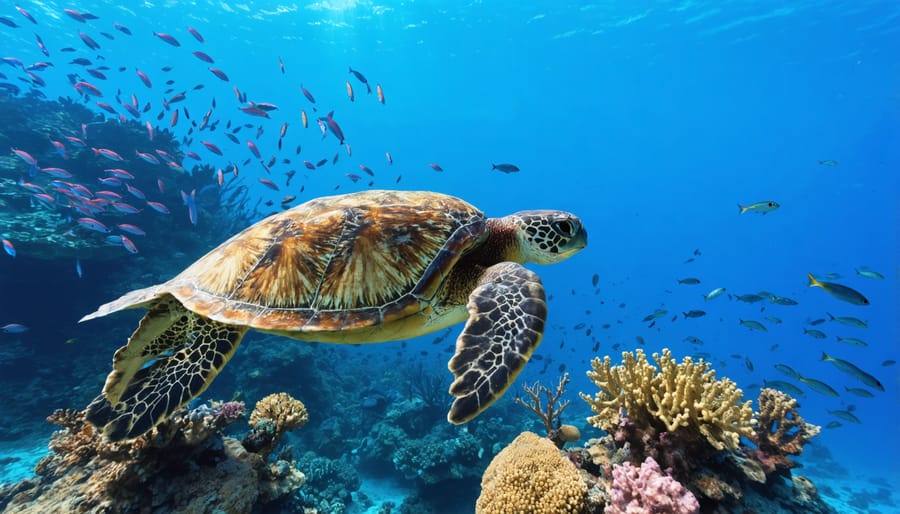
Dive into the vibrant zones of coral reefs, where intricate relationships between countless species create one of Earth’s most diverse and productive ecosystems. From the sun-drenched shallows to the mysterious depths, coral reefs teem with life, color, and wonder. Built by tiny coral polyps over millennia, these underwater oases support an astounding array of fish, invertebrates, algae, and microorganisms. Every creature plays a crucial role in maintaining the delicate balance of this complex web of life. Yet today, coral reefs face unprecedented threats from climate change, overfishing, pollution, and habitat destruction. The loss of these irreplaceable ecosystems would have devastating consequences for marine life and the countless communities who depend on them. By exploring the marvels of coral reef ecosystems, we can deepen our understanding, strengthen our resolve, and take action to protect these vital habitats for generations to come.
Structure and Formation
Coral Polyps
Coral polyps, the tiny architects of coral reefs, are the foundation of these underwater ecosystems. These soft-bodied organisms, related to jellyfish and anemones, secrete calcium carbonate to build protective skeletons around themselves. As polyps grow and divide, they create intricate coral colonies in various shapes and colors. The symbiotic relationship between coral polyps and microscopic algae called zooxanthellae is crucial for reef growth. The algae provide the polyps with essential nutrients through photosynthesis, while the polyps offer shelter and carbon dioxide for the algae. Over time, the collective efforts of countless coral polyps, along with the accumulation of calcium carbonate skeletons from deceased polyps, form the complex three-dimensional structure of the coral reef. This process of reef-building is slow, with some species growing only a few centimeters per year, highlighting the importance of preserving these delicate ecosystems for future generations.
Types of Coral Reefs
There are three main types of coral reefs: fringing, barrier, and atolls. Fringing reefs grow close to the shoreline, attached to the coast or separated by a narrow, shallow lagoon. They are the most common type of reef and can be found in the Caribbean, Red Sea, and parts of the Pacific Ocean. Barrier reefs, like the Great Barrier Reef in Australia, are separated from the mainland by a deeper, wider lagoon. They run parallel to the coast and can extend for hundreds of kilometers. Atolls are ring-shaped coral reefs that encircle a lagoon, often forming when a volcanic island subsides. Atolls are most common in the Indo-Pacific region, with famous examples including the Maldives and the Marshall Islands. Each type of reef provides unique habitats for a diverse array of marine life, making them crucial to the health and biodiversity of our oceans.

Biodiversity of Coral Reefs
Fish Species
Coral reefs are home to an astounding diversity of fish species, with estimates suggesting that they support up to 25% of all marine life. From vibrant parrotfish and angelfish to predatory sharks and rays, these underwater cities teem with a kaleidoscope of colors and shapes. Many fish species have developed unique adaptations to thrive in the complex coral reef environment, such as specialized mouth structures for feeding on specific prey or symbiotic relationships with other organisms. For example, clownfish find shelter among the stinging tentacles of sea anemones, while cleaner wrasses remove parasites from larger fish, forming mutually beneficial partnerships. The incredible variety of fish found in coral reefs not only adds to the beauty and wonder of these ecosystems but also plays crucial roles in maintaining the delicate ecological balance through complex food webs and nutrient cycling.
Invertebrates
Coral reefs are home to an astounding diversity of invertebrate species, with crustaceans and mollusks being among the most prominent. Crustaceans, such as crabs, shrimp, and lobsters, play vital roles in the reef ecosystem as scavengers, predators, and prey. For instance, the colorful mantis shrimp, known for its powerful punch, hunts small fish and crustaceans, while cleaner shrimp form symbiotic relationships with larger fish, removing parasites from their skin. Mollusks, including snails, clams, and octopuses, also thrive in coral reefs. Giant clams, which can grow up to 4 feet long, filter water and provide shelter for various organisms. Nudibranchs, colorful sea slugs, graze on sponges and algae, while octopuses use their intelligence and camouflage abilities to hunt and evade predators. These invertebrates, along with countless others, contribute to the complex food web and maintain the delicate balance of the coral reef ecosystem.
Symbiotic Relationships
Coral polyps and zooxanthellae algae engage in a remarkable symbiotic relationship that forms the foundation of coral reef ecosystems. The coral provides a protective home for the algae, while the zooxanthellae, through photosynthesis, supply the coral with essential nutrients and oxygen. In return, the coral’s waste products nourish the algae. This mutual partnership allows both organisms to thrive in nutrient-poor tropical waters. The vibrant colors of many coral species are due to the presence of zooxanthellae within their tissues. This symbiosis is crucial for the survival and growth of coral reefs, highlighting the delicate balance and interconnectedness of life in these underwater wonderlands.

Ecological Roles of Coral Reefs
Habitat and Shelter
Coral reefs serve as vital habitats and shelters for an astounding array of marine life. The complex structures formed by coral colonies provide countless nooks and crannies that offer protection and hiding spots for fish, crustaceans, and other organisms. Many species rely on coral reefs for their survival, using them as nurseries for their young, feeding grounds, and refuge from predators. The diverse range of microhabitats within a coral reef ecosystem supports an incredible level of biodiversity, with an estimated 25% of all marine species depending on these fragile ecosystems for their survival. Without healthy coral reefs, numerous species would face significant challenges and potential extinction.

Coastal Protection
Coral reefs serve as vital natural barriers, protecting coastal communities and ecosystems from the destructive forces of storms, waves, and erosion. The intricate structure of coral reefs dissipates wave energy, reducing the impact of powerful waves on shorelines. This protective function is especially crucial in regions prone to hurricanes and tropical storms, where coral reefs act as the first line of defense. By minimizing coastal erosion, coral reefs help maintain the integrity of beaches, mangrove forests, and seagrass beds, which in turn support diverse marine life and provide essential ecosystem services. As climate change intensifies storm events, the role of coral reefs in coastal protection becomes increasingly important for the resilience of both human communities and marine ecosystems.
Nutrient Cycling
Coral reefs play a vital role in nutrient cycling within marine ecosystems. The complex symbiotic relationship between coral polyps and zooxanthellae algae allows for efficient nutrient recycling. Zooxanthellae convert sunlight into energy, providing corals with essential nutrients. In turn, coral waste products nourish the algae. This closed-loop system minimizes nutrient loss and supports the reef’s productivity. Coral reefs also trap and recycle nutrients from the surrounding water, acting as nutrient sinks. When corals and other reef organisms die, their decomposition releases nutrients back into the ecosystem, supporting the growth of marine plants and phytoplankton, which form the base of the ocean’s food web.
Threats to Coral Reefs
Climate Change
Climate change poses a grave threat to coral reef ecosystems worldwide. Rising sea temperatures, caused by increasing greenhouse gas emissions, lead to coral bleaching events, where corals expel their symbiotic algae, turning white and becoming more susceptible to disease and death. Ocean acidification, another consequence of excessive carbon dioxide absorption, hinders coral growth and weakens their skeletal structure. As global temperatures continue to rise and oceans absorb more CO2, the frequency and severity of bleaching events and the rate of ocean acidification are expected to increase, putting the future of coral reefs in jeopardy. Urgent action to reduce greenhouse gas emissions and protect these fragile ecosystems is crucial for their survival.
Pollution and Sedimentation
Coral reefs are under threat from pollution and sedimentation caused by human activities. Nutrient pollution from agricultural runoff, sewage, and industrial waste can lead to algal blooms that smother corals and disrupt the delicate balance of the ecosystem. Sedimentation from coastal development, deforestation, and dredging can cloud the water, reducing the sunlight that corals need for photosynthesis. Oil spills and chemical contamination can directly harm coral colonies and the diverse marine life they support. To protect these fragile ecosystems, it is crucial to reduce pollution, implement sustainable land management practices, and support conservation efforts that aim to restore and safeguard coral reefs for future generations.
Overfishing and Destructive Fishing Practices
Overfishing and destructive fishing practices pose significant threats to coral reef ecosystems. Overfishing depletes key species, disrupting the delicate balance of these diverse habitats. Practices such as bottom trawling, dynamite fishing, and cyanide fishing cause direct physical damage to coral structures. The removal of herbivorous fish allows algae to overgrow and smother corals. Bycatch from non-selective fishing gear also harms other marine life. The cascading effects of these practices can lead to the collapse of entire reef ecosystems. Implementing sustainable fishing regulations, promoting responsible consumption, and supporting marine protected areas are crucial steps in protecting these vital habitats for future generations.
Conservation Efforts
Marine Protected Areas
Marine Protected Areas (MPAs) play a crucial role in conserving coral reefs by establishing designated zones where human activities are regulated or prohibited. These areas act as sanctuaries for marine life, allowing coral reefs to thrive and recover from external pressures. By limiting destructive practices such as overfishing, coastal development, and pollution, marine protected areas provide a safe haven for coral species and the diverse array of organisms that depend on them. Well-managed MPAs not only protect the immediate reef ecosystem but also contribute to the overall health and resilience of connected marine habitats. By preserving these vital ecosystems, marine protected areas ensure that coral reefs can continue to provide essential ecological services and support the livelihoods of countless communities worldwide.
Sustainable Tourism and Fishing Practices
Sustainable tourism and fishing practices are crucial for preserving the delicate balance of coral reef ecosystems. Responsible tourism involves minimizing physical damage to reefs, avoiding harmful sunscreens, and supporting local conservation efforts. Sustainable fishing practices, such as using selective fishing gear and respecting catch limits, help maintain healthy fish populations without disrupting the reef’s ecological balance. By adopting eco-friendly practices and supporting conservation initiatives, tourists and fishing communities can play a vital role in protecting these fragile underwater worlds for future generations. Through education and collaboration, we can ensure that coral reefs continue to thrive while providing sustainable livelihoods for coastal communities.
Conclusion
In conclusion, coral reef ecosystems are incredibly complex, diverse, and vital components of the marine environment. These underwater marvels support an astonishing array of life, from the vibrant corals themselves to the countless species of fish, invertebrates, and microorganisms that call them home. Beyond their inherent beauty and biodiversity, coral reefs provide essential ecosystem services, such as protecting coastlines, supporting fisheries, and attracting tourism.
However, coral reefs face numerous threats, including climate change, ocean acidification, pollution, and destructive fishing practices. The delicate balance of these ecosystems is easily disrupted, and once damaged, coral reefs can take decades or even centuries to recover. It is crucial that we take immediate action to protect and conserve these invaluable resources.
By understanding the intricacies of coral reef ecosystems and the challenges they face, we can work together to develop effective conservation strategies. This includes reducing greenhouse gas emissions, implementing sustainable fishing practices, minimizing pollution, and supporting marine protected areas. Furthermore, individuals can contribute by making eco-conscious choices, participating in beach clean-ups, and supporting organizations dedicated to marine conservation.
The future of coral reefs depends on our collective efforts. By taking action now, we can ensure that these awe-inspiring ecosystems continue to thrive, providing countless benefits to marine life and human communities for generations to come. Let us embrace our role as stewards of the ocean and work tirelessly to protect the delicate and irreplaceable wonders of coral reef ecosystems.
jessica
Ava Singh is an environmental writer and marine sustainability advocate with a deep commitment to protecting the world's oceans and coastal communities. With a background in environmental policy and a passion for storytelling, Ava brings complex topics to life through clear, engaging content that educates and empowers readers. At the Marine Biodiversity & Sustainability Learning Center, Ava focuses on sharing impactful stories about community engagement, policy innovations, and conservation strategies. Her writing bridges the gap between science and the public, encouraging people to take part in preserving marine biodiversity. When she’s not writing, Ava collaborates with local initiatives to promote eco-conscious living and sustainable development, ensuring her work makes a difference both on the page and in the real world.
